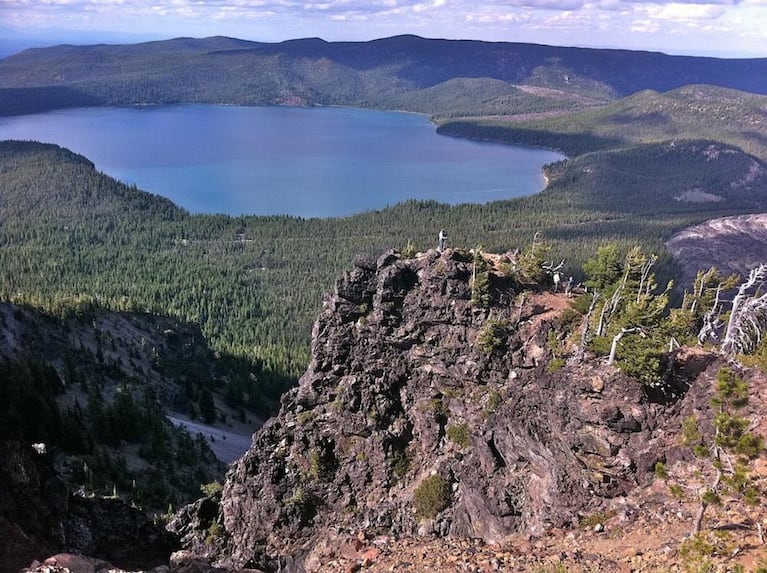
The view of Newberry Caldera from Paulina Peak. Geothermal experiments will happen just outside the volcanic monument boundary
Vince Patton
An experiment in Central Oregon geothermal energy got one step closer to approval Friday. The government has issued its environmental assessment and now the public has a month to comment. Two companies hope to try something earth shattering -- literally -- to get hot water out of a dry hole.
Geothermal energy depends on a simple, natural resource: hot water or steam.
If any place in Oregon would seem to hold genuine geothermal potential, it's the Newberry Crater about 30 miles south of Bend.
But the crater, part of the Newberry National Volcanic Monument, is protected.
No commercial drilling can happen inside its boundaries.
So it seemed a no-brainer to drill outside the monument on the flanks of the active volcano.
View Newberry Crater in a larger map
But the road to limitless power is paved with dry holes.
"We had very high temperatures in excess of 550 degrees Fahrenheit. We were very excited about that. But no hot water and no steam. It was heart breaking. We'd spent upwards of 30 million dollars at that point just for those two wells," says Gregory McClarren, spokesman for the company that drilled, Davenport Newberry.
That was in 2008.
Now Davenport Newberry has a partner.
AltaRock Energy has a plan that might still get hot water out of those dry holes.
It's called "E-G-S."
Will Osborn is AltaRock's project manager at the Newberry EGS experiment.
"We're enhancing the productivity of the geology of the earth to produce hot water," he says.
Since there's no water down below, they'll pump cold water down.
That will create a water storage area nearly 2 miles underground by breaking the rock with high-pressure water.
"We use the natural fractures in the rock. So when we inject water at high pressure we're opening up the natural fractures in the rock and just causing those to slip a little bit. When they slip, the irregularities in the rock will cause those cracks to remain open," Osborn explains.
Those tiny cracks would become the storage.
Enough fractures, they hope, to store 50 million to 75 million gallons of water down there.
Map shows where people might feel ground shaking if geothermal injections trigger a 3.5 magnitude quake. Source: BLM Environmental Assessment
The federal environmental assessment predicts there will be no impact on local groundwater quality or quantity from the project.
The idea is to make a closed loop.
Cold water gets pumped down into the superheated rock.
They would drill other wells off to the side to pump the hot water out, which would then power turbines to make electricity. Once cooled, the water would be pumped back down to be heated again and again.
There is likely to be one side effect of forcing so many cracks into the subterranean rocks: lots of very small earthquakes.
Most under magnitude one.
"In this case we're not talking about earthquakes so much as micro-seismic events. Generally they don't get large enough to be felt," Osborn says.
Osborn says a few quakes could reach magnitude 3.5 or 4.
A report prepared for Altarock says larger quakes could be felt in LaPine or Sunriver, each about a 20-minute drive away.
AltaRock calls any man-made quakes more of a nuisance than a hazard - and predicts they would not be strong enough to cause any damage.
Shattering the earth with fluid sounds a lot like one of the energy industry's most controversial practices. It draws comparisons to hydraulic fracturing, or "fracking," where drillers fracture the rock to extract natural gas. Osborn says there's a big difference.
"In hydrofracking done in the oil and gas industry, they actually shatter the rock. They break the rock and create new cracks, new fractures in the rock. We just inject cold, clean groundwater," Osborn says. "In hydrofracking they use a mixture of chemicals."
The company is installing sensors to map even the tiniest seismic activity.
It so happens that the U.S. Geological Survey also installed brand new sensors around Newberry this year. That project has nothing to do with the geothermal test.
But USGS geologist Ben Pauk says it puts them in a great place to know if water injections have wider side effects.
"We will be in a better position to distinguish if the earthquakes that are occurring as a result of the injection are indeed the result of the injection or they're the result of magma accumulating in the magma chamber beneath the volcano," Pauk says.
Taxpayers are funding this geothermal research. The U.S. Department of Energy is providing $22 million. AltaRock and Davenport Newberry are matching that with another $22 million of their own.
The first injections and subterranean fracturing could begin next summer.
(The public has the next month to offer opinions on the project to the government. You can see even more about this later this season on OPB-TV's Oregon Field Guide.)



